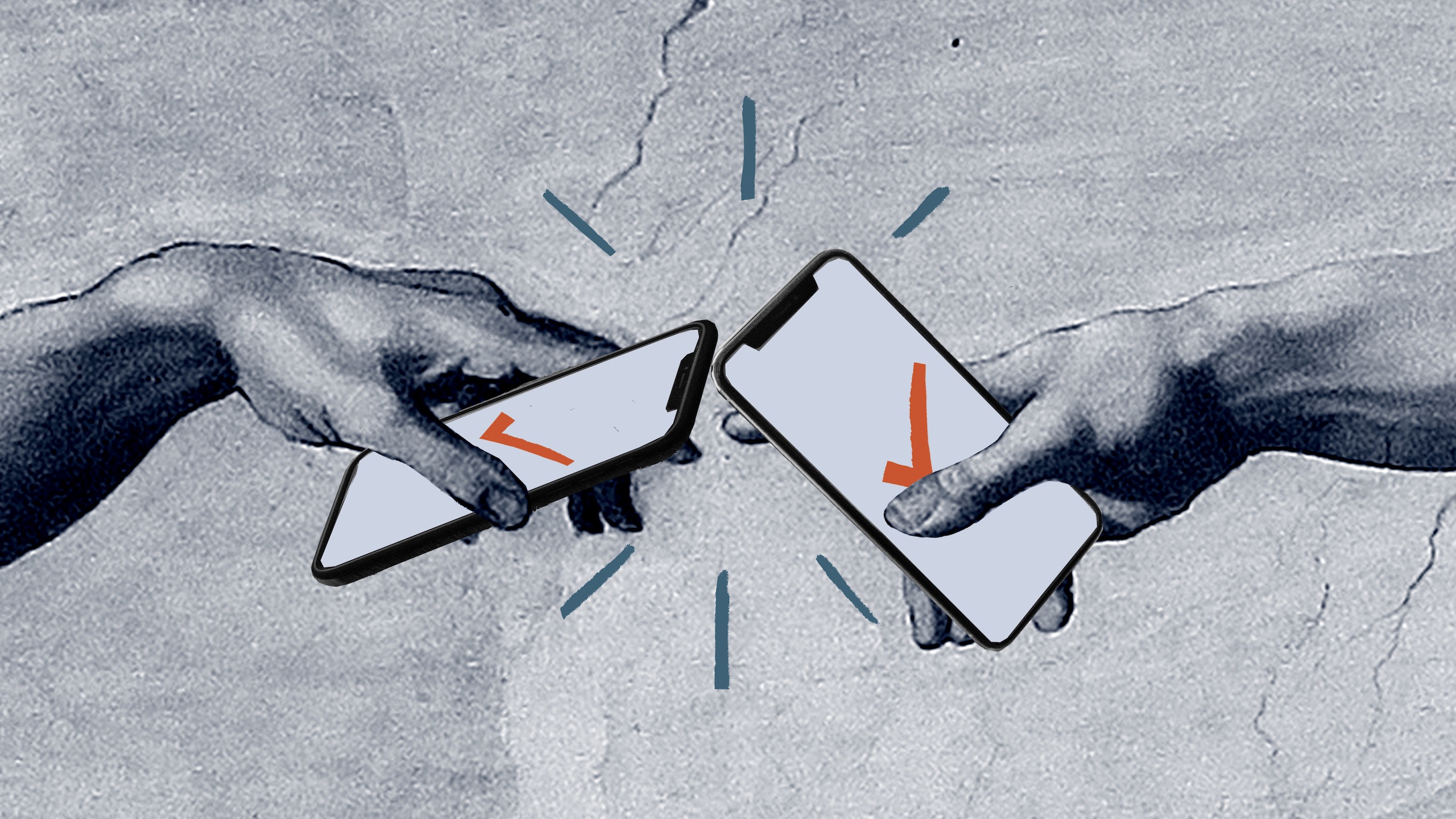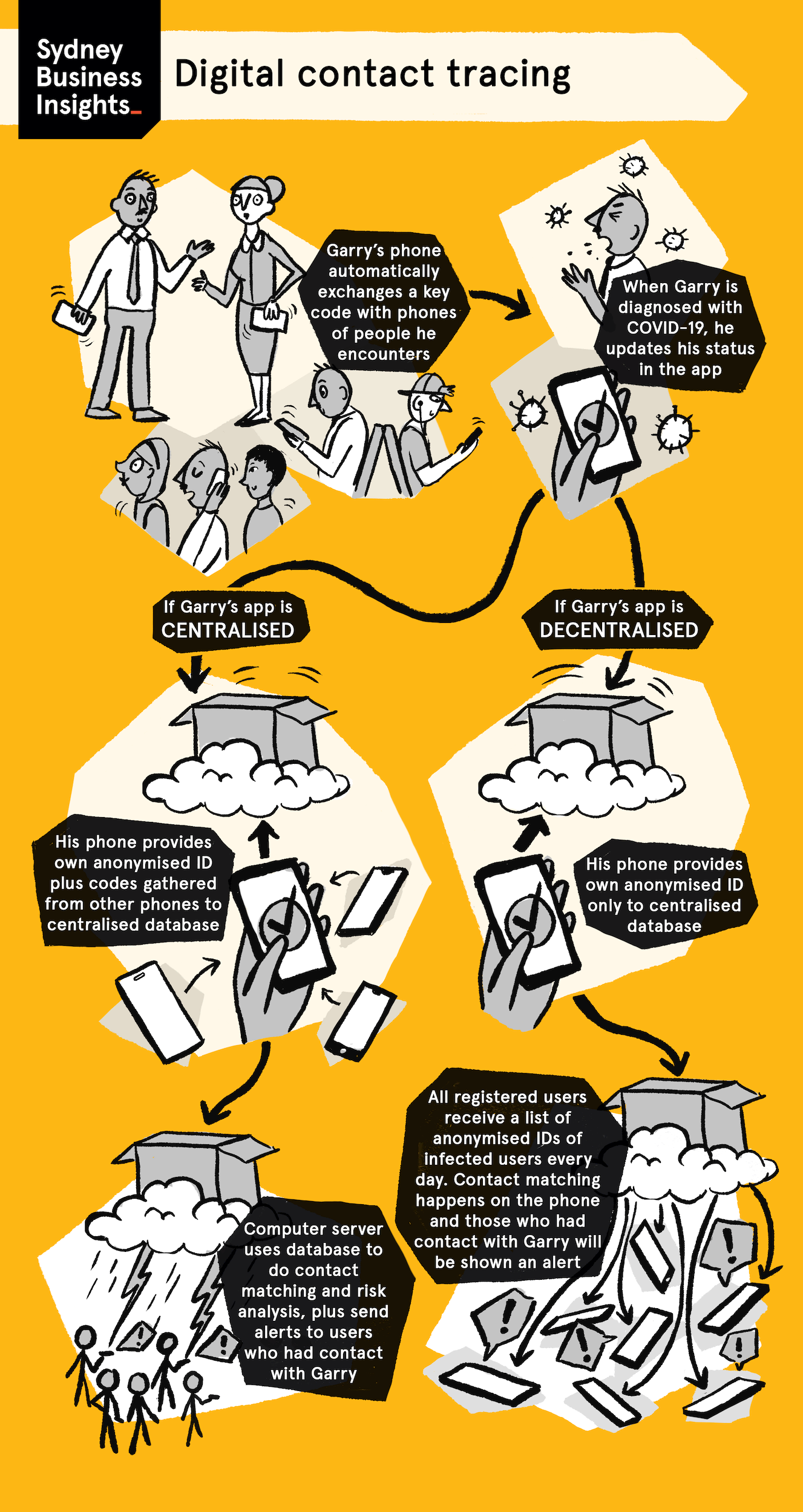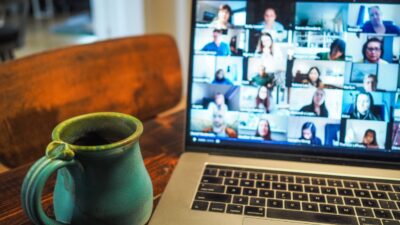Sandra Peter and Kai RiemerSandra Peter, Kai Riemer,
text

Digital contact tracing on Corona Business Insights
We catch up on the latest in digital contact tracing, both in the public sphere and emerging corporate solutions.
As COVID-19 sets out to change the world forever, join Sandra Peter and Kai Riemer as they think about what’s to come in the future of business.
Shownotes
Our previous discussion on contact tracing on The Future, This Week
Contact tracing apps and trust
Glitches dent German enthusiasm for COVID contact-tracing app
NMSU students develop a contact tracing app for staff and students
Asset tracking system to enable employers to conduct COVID-19 contact tracing in the workplace
Our previous discussion on corporate surveillance on Corona Business Insights
GlaxoSmithKline tells staff to turn off contact-tracing app while at work
Our contact tracing resource page
This episode is part of a podcast series covering what COVID-19 will mean for the business world, where we look at the impact on the economy, businesses, industries, workers and society. This is part of our ongoing coverage of the impact of COVID-19 on the future of business.
Follow the show on Apple Podcasts, Spotify, Overcast, Google Podcasts, Pocket Casts or wherever you get your podcasts. You can follow Sydney Business Insights on Flipboard, LinkedIn, Twitter and WeChat to keep updated with our latest insights.
Send us your news ideas to sbi@sydney.edu.au.
Dr Sandra Peter is the Director of Sydney Executive Plus at the University of Sydney Business School. Her research and practice focuses on engaging with the future in productive ways, and the impact of emerging technologies on business and society.
Kai Riemer is Professor of Information Technology and Organisation, and Director of Sydney Executive Plus at the University of Sydney Business School. Kai's research interest is in Disruptive Technologies, Enterprise Social Media, Virtual Work, Collaborative Technologies and the Philosophy of Technology.
Share
We believe in open and honest access to knowledge. We use a Creative Commons Attribution NoDerivatives licence for our articles and podcasts, so you can republish them for free, online or in print.
Transcript
Intro From the University of Sydney Business School, this is Sydney Business Insights.
Sandra And this is Corona Business Insights. I'm Sandra Peter.
Kai And I'm Kai Riemer.
Sandra And we're back unpacking the impact of COVID-19 on business, the economy, industry, government, workers and society, and looking at the effects of the pandemic.
Kai And this podcast is part of a larger initiative by the University of Sydney Business School.
Sandra You can find our COVID business impact dashboard online at sbi.sydney.edu.au/coronavirus.
Kai And today we catch up on the latest developments in contact tracing, both in the public space and corporate solutions.
Sandra And whilst the topic has been on and off in the news, it's been a constant companion throughout the pandemic. So we're doing this episode to complement a whole resource page that the University of Sydney Business School and Sydney Business Insights are putting out with data around contact tracing apps around the world, but also around corporate solutions, around differences, challenges with privacy, governance, adoption, and so on. And you will be able to find all those resources at sbi.sydney.edu.au/contact-tracing.
Kai And so contact tracing is really one of those topics that have gone through a full hype cycle. In the beginning, there was a lot of hype around contact tracing apps, and how they would help curb the spread of the virus. Then, it turned out it wasn't all that easy and the coverage in the media turned decidedly negative. There was issues with the adoption of these apps, issues around privacy and false positives. And then it's gotten really quiet around contact tracing apps. But it turns out, technology has progressed, there's now a lot of private companies that offer contact tracing solutions for corporates and many countries have successfully rolled out and are actually using these apps to help with the contact tracing efforts. Now that a second wave is underway worldwide, so it's really time to catch up on what's going on in this space.
Sandra So contact tracing is a public health practice that aims to identify and notify those people who have had contact with or have been in locations that an infected person has visited during the period that they were contagious. And for most other pandemics, we have had manual contact tracing, which is still a large part of the effort for contact tracing, even in places like Australia, where people obtain consent from an infected person to retrace their whereabouts during the contagious period, and then go and reach out to the people that they have been in contact with asking them to isolate and testing them for the coronavirus. But digital contact tracing has been a new feature of this pandemic and has offered a range of technology solutions to help with the shortcomings of manual contact tracing. If you have five cases, that's not so difficult to do, but once you get into the 10,000 cases a day, the number of potential contacts grows exponentially, and it becomes a task that can no longer be performed manually.
Kai Cases are growing exponentially. It turns out that technology can help with the tracing and places that had prior experience with pandemics such as South Korea or Singapore or even China that were experienced with SARS and MERS were the first ones to employ technology to help. So in South Korea, for example, they employed what we now called surveillance tracing, they used all kinds of digital information that was available from CCTV cameras, the equivalent of the opal card, credit card information to trace the whereabouts of people and identify locations where the virus might have spread. But that obviously is highly intrusive in terms of privacy and while people in South Korea, given the history with SARS, we're on board with this, those solutions wouldn't fly in other parts of the world. So countries and also corporations were quick to explore other ways in which digital technology could help with contact tracing.
Sandra So a range of other technology solutions emerged, first in places like Singapore, and indeed in Australia. And this was based on the idea of having an app and collecting data whilst people are going about their day by measuring how long they spend in each other's proximity.
Kai So this uses the Bluetooth low energy of smartphones to pick up when people with smartphones are in proximity with each other registering on the phone, while the contact occurs that there was a contact. And so when someone later tests positive, that information of who they were in contact with could then be used to contact those people. So you don't actually have to ascertain the locations in which people were, you actually collect those contacts as they go about their daily business on those smartphones.
Sandra And initially, these apps appeared in places like Singapore where Singapore's Trace Together or Australia's COVIDSafe. And initially, they relied on the fact that people would register their phone number with a central computer server, which would then give you those anonymised IDs. Thus, anonymity and privacy would be preserved between people, but would still be disclosed to a central authority, a central location in the case of Australia and Singapore, this being government health agencies.
Kai And crucially, all the infected users would be contacted by the centralised server. So privacy is still an issue here because both the users being exposed and the person testing positive would be identified vis-à-vis the health authority. And that actually is a good thing from a control of the spread perspective, because that data can then tie in and flow into the manual contact tracing, because potential contacts are disclosed to the authority. But it did raise a lot of privacy issues and therefore fears that people might not want to adopt those apps because they do not want to identify themselves vis-à-vis the government.
Sandra Hence, in the beginning of April, the two companies that pretty much dominate the operating system for smartphones, Apple and Google, announced a joint solution that would do away with the idea of having a central authority in charge of this and allowing decentralised proximity tracing, which means that people would register with a central service anonymously rather than using their mobile phone numbers. And people's phones themselves would look for the infected contacts rather than relying on a central server.
Kai So this preserves the privacy of all the users vis-à-vis, the centralised authority, but it comes at a price. While the server still knows how many anonymous users have lodged the process of notifying others, there is no information about who was potentially exposed, the privacy of those potentially exposed people is preserved. And Google and Apple actually called this "privacy preserving contact tracing," in the beginning, it was later renamed as the exposure notification API, which indeed underpins many of the apps that have been launched worldwide since, in places such as Germany, Ireland, Canada, Switzerland, and nowadays in many states of the US where individual states are launching their own individual apps.
Sandra So when it comes to digital contact tracing, we end up with these three baskets. One is centralised proximity tracing, that is countries like Singapore and Australia, we have decentralised proximity tracing that relies on the Apple/Google solution that we see in many, many places around the world. Even in some countries like the UK, we see governments switching from a centralised solution to a decentralised one relying on Apple, Google. And we still have the places that use surveillance tracing. So South Korea is a good example of that, and China is another example of places that rely on surveillance tracing.
Kai And it's really interesting that the early movers such as Singapore and Australia, are now using a centralised solution that, in some respects, is technologically outdated, but does offer certain benefits when it comes to combining manual and digital contact tracing.
Sandra And another plug here for all the resources on the website where you will be able to find details for contact tracing around the world. And you'll be able to see the types of technology that they use whether or not it's voluntary, centralised, decentralised, penetration/diffusion, what percentage of the population is using the app and so on. But before we wrap up today, there is another very interesting space that has emerged in contact tracing around corporate contact tracing.
Kai Yes, so there's a number of corporate solution to contact tracing that have emerged. And this is in part due to a lack of action in places like the US where the federal government has abstained from making any moves to support contact tracing where it was left to the states that have been fairly slow in many places, so corporates have stepped in, and are offering their own solutions that help their corporate clients to do contact tracing on their premises to help curb the spread, and also the liability of you know, having infections in the workplace so that companies can adopt solutions that at least help with the contact tracing within their workforce.
Sandra And there has been a number of companies from different fields that have come to this was there's new players in the field that have just developed these apps, there's a range of companies that were already doing checking for organisations or inventory tracing for organisations that have pivoted their business models to now also do conduct tracing. And whilst the online resources will give you a comprehensive table with a range of approaches that are being employed, it's worth mentioning a few different types that have emerged.
Kai Yeah, so we are distinguishing five different types that you can find in more detail on the website. The first one will be check-in tracing. So we see this in coffee shops and restaurants a lot where you scan a QR code that allow you to register that you are on premise. But there's also professional solution for corporates where employees and guests are now asked to register that they are on premise and companies that already did visitor management have now added this to their software solutions.
Sandra There's also proximity tracing solutions, like the ones we see at the government level that are employed in specific companies. And we've discussed in previous podcasts solutions like the PwC ones, they either rely on smartphone apps or on tokens or badges that people have to tell how close individuals have been to each other and then notify them if there was someone infected.
Kai Yeah, that's really interesting, and so there's some Internet of Things, IoT startups that don't use apps, but these little Bluetooth tokens that do exactly the same, but do not require people to install an app on their smartphones.
Kai There's an extension of that, which is location tracing, which doesn't just register contacts between people, but also contacts with Bluetooth beacons, like little stations that are scattered throughout the premises, so that the company knows where people have been, which locations they have frequented. And interestingly, companies that used to do just asset tracking, you know, where's my drill, where's my digger on a construction site, have pivoted to just put badges on people. So they're tracking people on construction sites, in warehouses, in hospitals, in different premises.
Sandra It's also one of the solutions that is more easily implementable. We've seen, for instance, in the US universities like New Mexico State University, where students have developed such apps in the absence of a national or state level solution.
Kai And then there's also a form of surveillance tracing, companies that combine data from badges, WiFi data, bookings, of meeting rooms, calendar data, work shift logs to create elaborate dashboards that allow companies to trace the whereabouts of people and then establish contacts, should there be a positive test among their workforce.
Sandra And then finally, there's integrated solutions that combine all of these things with systems that companies already have. So think about health facilities or nursing homes or clinics where you already know where people are, people are rostered. And you can use that information to ensure not only that people who have come in contact with infected people are not working or not on the premises, but also to ensure that you organise work in such a way as to reduce the potential for infection.
Kai Yeah, you can, for example, divide your workforce, have certain teams always work together so that you manage your risk. If there isn't exposure, you don't spread it too widely across the entire workforce.
Sandra So of course, contact tracing, whether at the national level or at the corporate level is not without its controversies. There's been lots written in the press around adoptions, efficiency, number of notifications, and so on to do with national digital contact tracing. And in the corporate space, there's been a lot of discussion around corporate surveillance, we indeed did a whole episode on corporate surveillance, where health solutions were only part of the debate, and we'll put that link in the show notes. But there's also increasing tensions between the national contact tracing apps and the corporate ones. Just recently, the British pharmaceutical company GlaxoSmithKline told their stuff to turn off their official national contact tracing app.
Kai And so what the company is worried about here is false positives. So Glaxo has said that they have implemented safe work practices, they minimise the risk of transmission and exposure in their workplace. And so what they're worried about is that the app will pick up lots of proximity contacts by people who are on premise. And then should someone test positive because they were exposed outside of the workplace, you know, going to a restaurant or a bar, it would mean that a large number of their workforce would have to isolate for 14 days.
Sandra Yet the app is seen as an integral part of the UK government's Test and Trace program hence such practices can severely undermine the government efforts to have such conduct tracing apps adopted and used by the population.
Kai And it is also curious because the existence of many of the corporate solutions show that other employers are much more concerned with the liability of infections in the workplace, and they make sure that people are in fact traced on premise so that the risk of transmission is minimised, and they try to err on the side of caution. So it's quite interesting these different approaches that somewhat mirror the discussion that we've seen in the public space around false positives, around adoption rates, around privacy and the efficacy of these apps when only partly adopted.
Sandra And we have actually done research here at the University of Sydney Business School on the challenges of contact tracing adoption.
Kai Where we look into the tensions between creating a public good by widespread adoption of these apps in a population and the individual right to privacy and to abstain from adoption, which creates a free riding problem. And therefore the challenge that governments face in rolling out and nudging people into adopting the apps and we're comparing different cultural settings, Asian countries, Europe, the US and how governments would go about making sure that digital contact tracing can be successful.
Sandra And you can find this research and all the data that we discussed on this episode, including contact racing around the world and corporate contact tracing on sbi.sydney.edu.au/contact-tracing.
Kai And this is where we want to leave it today. Until next time, this was Corona Business Insights.
Sandra Thanks for listening.
Sandra Thanks for listening.
Outro From the University of Sydney Business School. This is Sydney Business Insights, the podcast that explores the future of business.
Close transcript






